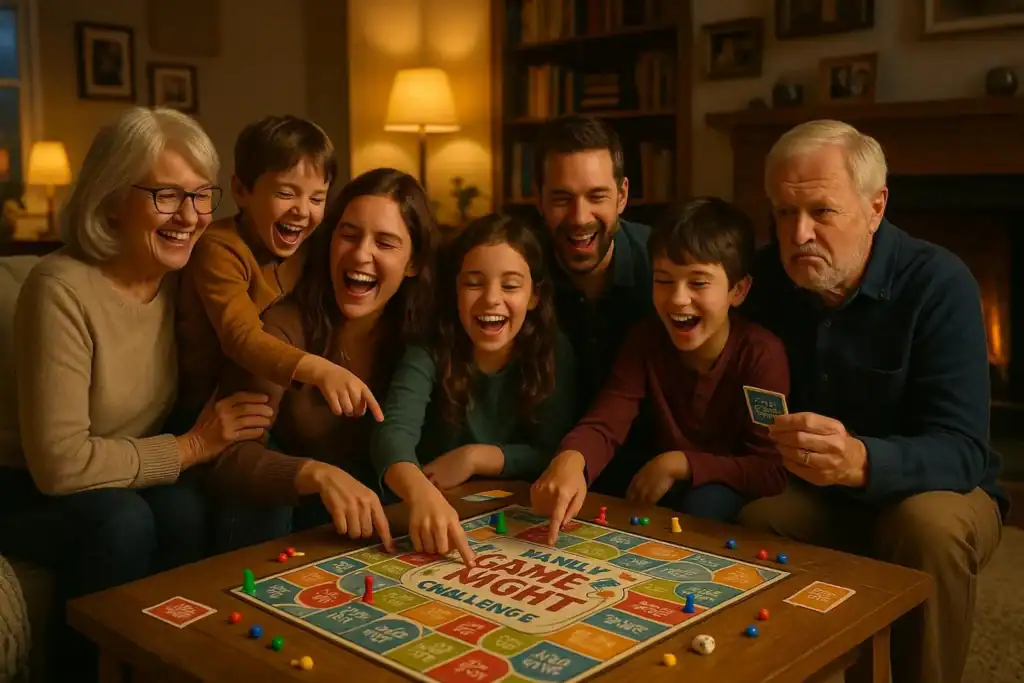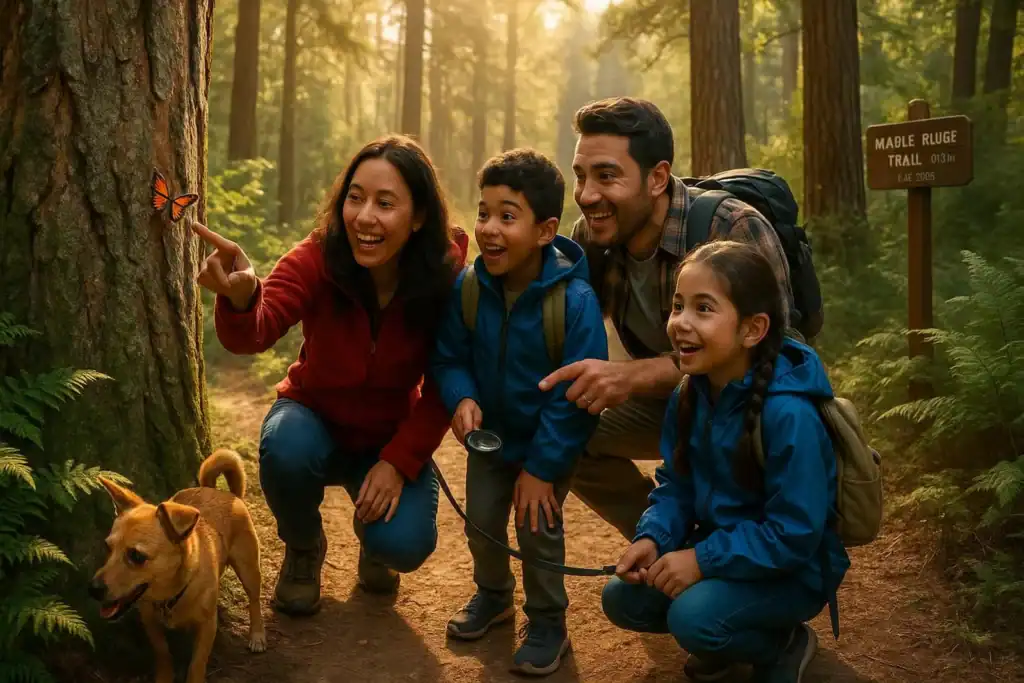Life moves fast. Calendars are packed, and screens pull us in at every turn. Finding time for family matters a lot. The key is to be intentional and present. Make space, big or small, to connect, talk, and share moments that bring you closer. This guide explains what quality family time means, why it helps, simple ways to fit it into busy days, and plenty of ideas to make each moment count.
What Defines Quality Time with Family?
Quality time isn’t just being in the same room. It’s about real attention, shared moments, and honest conversations. It happens when everyone is mentally and emotionally present and distractions are set aside. It can be planned or spontaneous, long or short, but the heart of it is giving each other focused attention on purpose.
For example, one parent found meaningful time by lying next to their kids at night and talking about the day. No big plan, just time to listen and share. That is quality time: eye contact, open talk, and the feeling that each person matters.

How Quality Time Strengthens Family Bonds
Time together builds trust, respect, and closeness. Shared moments turn into stories, jokes, and memories that make a family feel like a team. Doing things together sends a clear message: you belong here, and you are valued.
Laughing during a game, working on a project, or chatting during a walk all add to an “emotional savings account” you can draw from during hard days. These moments teach empathy, teamwork, and how to handle conflicts. Over time, they create a steady, loving space where everyone feels supported.
Common Barriers to Spending Meaningful Time Together
- Busy schedules: Work, school, activities, and chores can fill every hour and leave little space to connect.
- Technology: Phones, tablets, and TV can pull attention away and create quiet distance between people.
- Cost myths: Some think meaningful time needs pricey outings, but many of the best ideas are free or low-cost.
Many weekends feel like a race from games to parties to errands. Without a plan, there’s little room left for simple time together. And while devices are useful, they can also become barriers. The good news: many powerful family activities are simple and inexpensive.
Top Benefits of Spending Quality Time with Family
Consistent time together helps everyone in the family feel safe, heard, and connected. It supports personal growth and stronger relationships that last.
| Benefit | Quick examples |
|---|---|
| Better communication | Talking at dinner, chats in the car, checking in before bed |
| Lasting memories | Game nights, road trips, reading together, small traditions |
| Lower stress | Walks, play, shared laughter, quiet bedtime talks |
| Emotional growth | Practicing listening, teamwork, and problem-solving |

Improves Communication and Understanding
Regular time together opens the door for honest talk. Meals, rides, and shared activities create chances to share feelings and stories. This helps everyone see different points of view and reduces misunderstandings. A simple dinner gives parents a chance to hear about a child’s day and answer questions.
Frequent contact also helps family members notice tone, mood, and body language. Kids learn how to express needs and listen well by watching adults. Over time, this builds emotional skills and makes relationships smoother and kinder.
Builds Lifelong Memories
Shared experiences become stories that stick. A game night that went sideways, a road trip detour, or a calm evening reading together can become family legends. These memories make people feel rooted and connected.
Think of roasting marshmallows in the living room after a canceled camping trip, or letting a child pick a restaurant for a special lunch. These small, imperfect moments are the ones that last. They remind everyone of love, belonging, and home.
Reduces Stress for Adults and Children
Time with loved ones helps everyone relax. Adults get a break from work pressure. Laughter and comfort reset the mind. Being with people who care about you is a natural stress reliever.
Kids feel safer when family time is steady. A reliable routine helps them handle school and social stress. Play releases feel-good chemicals, and simple habits like a bedtime talk or prayer can calm worries before sleep.
Supports Healthy Emotional Development
Kids grow emotionally when they spend steady, positive time with family. They watch how others handle feelings and learn to do the same. When adults listen and show empathy, children feel seen and build confidence.
Shared activities teach cooperation, compromise, and how to solve problems. These skills help kids build strong friendships and future relationships. Consistent, caring contact at home gives them a solid base of safety and belonging.
How to Incorporate Family Time into a Busy Schedule
“Too busy” is common, but small, planned changes can open up space. You don’t need more hours-use the ones you have with care.
Prioritizing Family Activities in Daily Life
Decide that family time matters and treat it like any other important appointment. Put it on the calendar. Ideas include:
- A weekly game night or Sunday walk
- One-on-one “dates” with each child
- Experience “coupons” (museum trip, ballet, science center) to use across the year
Also look for moments already in your day. Turn commutes into talk time. Keep dinner simple but regular. Read a chapter together each night, or spend 10 focused minutes with each child before bed. Small, steady moments add up.
Setting Boundaries with Work and Technology
Set clear limits so family time doesn’t get pushed aside. Pick work hours and unplug outside them. Try not to check email after dinner. Leave work at work when you can-both physically and mentally.
Phones can steal attention fast. Try “do-not-disturb” during family time, create tech-free zones at meals, and set tech-free hours for certain activities. These habits help everyone stay present. It may feel hard at first, but it protects the time that brings you closer.
The Best Ideas for Spending Quality Time with Family
To enrich family life, choose activities that fit your interests and energy. The best ideas are the ones your family enjoys together.
1. Eat Meals Together Regularly
The table is a classic meeting place. Dinner is a daily chance to talk and reconnect. Many families aim to eat together as often as they can, using that time to share stories and relax after a busy day.
Breakfast can work too. Even a short meal sets a friendly tone. Sharing food builds closeness and creates a steady rhythm that brings everyone together.
2. Plan Family Game Nights
Games invite laughter, teamwork, and fun competition. Board games, charades, and card games like Uno spark talk and play. Choose games that match your kids’ interests-even playing pretend or acting out silly scenes can be a hit.
Game nights teach sportsmanship and help people unwind. The funny moments and surprise wins turn into favorite family stories.
3. Explore Outdoor Activities
Fresh air and open spaces make great backdrops for bonding. Try a nature walk, a beach trip, a National Park visit, or a backyard picnic. Even a short walk with “I Spy” can feel like an adventure.
Mix in simple movement: family walks or bike rides, playground time, or a mini “family Olympics” at a local track. Moving side-by-side often makes it easier to talk about tougher topics.

4. Take Weekend or Day Trips
A short break from routine can refresh family life. Try an overnight in a nearby town, be tourists in your own city, or visit a museum, zoo, aquarium, festival, or farmer’s market. Some families trade birthday parties for a special overnight trip together.
Trips don’t need to be fancy. A drive to the next town for a new restaurant, a local history site, or a theme or water park can feel special. Planning together is part of the fun.
5. Start a Family Project or Hobby
Working on something as a team brings people closer. Try a craft, fix an old bike, plant a garden, paint a room, or build a Lego town. Creating something side-by-side builds pride and connection.
Get creative: write and illustrate a story, or put on family plays. Planning, doing, and finishing together builds teamwork and helps everyone notice each other’s strengths.
6. Read Together as a Family
Reading together is calm, close, and screen-free. Read aloud to kids (even older ones), or sit together and read your own books for half an hour. Many parents enjoy sharing a favorite childhood book one chapter at a time.
Stories spark conversation and share values in a gentle way. Reading feeds imagination, grows vocabulary, and creates a cozy ritual. With older kids, try a family book club.
7. Volunteer or Give Back as a Group
Helping others as a family builds empathy and purpose. Find a cause you care about and jump in together. Ideas include donating blankets to an animal shelter, joining a 5k for a cause, or picking a local charity to support.
Teens often want to make a difference. Choosing and serving together leads to good talks, new perspectives, and a shared sense of impact.
8. Celebrate Family Traditions and Special Events
Traditions give families a shared identity. Celebrate holidays, cook special meals, or make your own customs-like a yearly “mystery day” or a birthday game.
Older relatives can explain how traditions began and why they matter. Invite kids to help carry them forward. Even simple moments, like watching the sunrise together, can become meaningful traditions.
9. Share Daily Stories and Experiences
Regular conversation is powerful. Make space to talk at dinner, on the drive home, or before bed. One parent’s favorite moment is a bedtime chat about the day-short, simple, and honest.
Use open-ended questions: “What was the funniest thing today?” or “If you could have any superpower, what would it be?” Teens may share less, so set a short check-in time each day so they know you’re available. Small, steady talks build trust.
Choosing Activities for Different Family Members
Good family time fits each person’s needs and interests. What excites a toddler may not appeal to a teen, and what a spouse enjoys may differ from what a grandparent likes. Adjusting plans helps everyone feel seen and involved.
Ideas for Young Children
Little kids love to join in. Many activities feel magical to them. Go on “discovery walks” and look for bugs, birds, and flowers. Play on the playground-go down the slide with them.
Make-believe works wonders. Follow their lead with costumes and silly voices. Read your old favorite books aloud. Camp in the living room. Put on a home show. Leave small surprises, like a happy note or a short video, to make them smile. Get on their level and share their curiosity.
Ways to Connect with Teenagers
Time with teens can feel tricky. They want independence and time with friends. With a little effort, daily connection is still possible. Use car rides or bus rides to talk-there’s not much else to do, and side-by-side talk can feel easier.
Show real interest in what they love. Join their activity if you can, or let them teach you about it. Welcome their friends when possible. Short, reliable check-ins-when they get home or before bed-send a clear message: “I’m here for you.” Small and steady beats rare and grand.

Meaningful Activities with Parents and Grandparents
As parents and grandparents grow older, steady contact matters. Simple calls or texts to say hello and ask about their day go a long way. Invite grandkids to call too.
Plan a weekly meal or cook a family recipe together. Try a new hobby-tai chi, a language class, or a craft-to spark fresh conversation. Share family stories and look through photo albums to connect generations and pass along history. Even errands or a walk in the park can be special time together.
Quality Time for Couples within the Family
In busy seasons, couples sometimes set each other aside without meaning to. Care for your relationship on purpose. Small gestures, like a short note, matter.
Build quick touchpoints into the day-like a simple breakfast together. Try at-home dates: a movie with a favorite snack or a couples card game. Also plan regular outings: dinner, a movie, or recreating your first date. Dessert dates are easy and fun. Set aside weekly time for each other that isn’t about chores-just connection and joy.
Tips for Making Family Time More Enjoyable and Lasting
Showing up is the start. The next step is creating a warm, open space where everyone feels welcome and heard.
Encouraging Participation and Openness
Invite everyone to help plan. Let kids pick activities sometimes, or vote on choices. Joining kids in what they love-even if it’s not your favorite-shows respect and builds trust.
Practice active listening. Ask questions that invite stories: “What made you laugh today?” or “What was a challenge you handled?” Keep judgment out of the room. Even 10 minutes of full attention with each child can make a big difference.
Limiting Distractions During Family Activities
Distractions can break connection fast. Set simple rules to protect your time. Try “no phones at the table,” tech-free zones, or tech-free hours for certain activities. As one tip puts it, “put your phone down, leave it on ‘do-not-disturb’ for a moment.” Make this a family habit.
Pause chores and avoid multitasking during family time. Be fully present. It takes practice, but this focus makes moments richer and more memorable.
Creating New Family Rituals
Rituals add comfort and rhythm. You can start new ones anytime. Simple works best: weekly pizza-and-movie night, Sunday pancakes, or a nightly reading routine.
Pick rituals that fit your family’s style. Try a “campfire story” round where everyone adds a piece, or a monthly “adventure day” to explore a new spot. These regular touchpoints become anchors that bring people together and keep families close.
Frequently Asked Questions about Family Quality Time
Families often ask similar questions about shared time. Here are clear answers to the most common ones.
How Much Time Should Families Spend Together Weekly?
There isn’t a single right number. Quality matters more than quantity. A short, focused talk can matter more than hours in the same room while everyone is on a device.
Still, steady contact helps. Aim for daily small moments plus a few longer stretches each week. Examples: regular meals, 10-15 minutes of one-on-one time with each child before bed, and a longer activity on the weekend. The main point is to choose connection on purpose, again and again.
What if Family Members Have Different Interests?
Different interests are normal. Take turns choosing activities. One week could be a hike; the next, a board game. This teaches compromise and opens new doors for everyone.
Pick activities with broad appeal, or join someone in what they love even if it isn’t your favorite. Support speaks volumes. As one parent said, they don’t love every activity-but they love their kids, so they join in. That kind of care strengthens bonds.
Should Family Time Be Scheduled or Spontaneous?
Use both. Put regular time on the calendar so it actually happens-like game night or a weekly outing. Planning helps build habits.
Also welcome surprise moments: a kitchen dance party, a last-minute sunset watch, or a deep car-ride chat. Be ready to say yes when a good moment appears. Whether planned or spur-of-the-moment, the goal is to choose connection.
Key Takeaways for Building Stronger Family Connections
Family life can be busy and messy, but quality time holds it together. Your family is worth your time and attention. The ideas here are a starting point-shape them to fit your people. You don’t need lots of money or free time. Small, steady moments make a big impact. Share meals, play games, talk often, and take simple trips. With each intentional choice, you add to your family’s story. The laughter you share and the comfort of belonging create a legacy of love and strength. Make memories and enjoy the gift of your family.








































